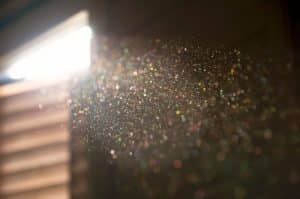As a contributing factor towards eye irritation and conditions such as dry eye syndrome, dry air can be a pain.[1] In this article, we explore what dry air actually is and what causes it, helping you to understand how you can combat this uncomfortable environmental condition.
What is dry air?
The term ‘dry air’ is something of a misnomer, as the air we breathe and that surrounds us is never truly dry. It always contains some degree of moisture in the form of water vapour, and the amount of water vapour in the air – also known as the humidity – determines how ‘wet’ or ‘dry’ the air feels.
It’s important to note that when you see humidity discussed on weather reports, the meteorologist is usually actually talking about ‘relative humidity’, which is slightly different. Relative humidity takes into account how much water vapour the air could hold at the temperature it is. This is because the air can hold different amounts of moisture at different temperatures – so 50% humidity at 20°C would feel more moist than 50% humidity at 0°C.
When we talk about dry air in terms of the effects it can have on our health, it’s generally the overall humidity that has the biggest impact rather than relative humidity. However, relative humidity can help to explain certain trends of dry air seasonality.
What dries out the air?
Lots of things can lead to dry air in your home or place of work, and combatting these can help to avoid the problems caused by dry eye syndrome. Below, we look at some common culprits.
Cold weather
As we’ve mentioned, the ambient temperature hugely affects how much moisture the air can hold, which is why dry eye syndrome can be more common in winter. It’s been suggested that a relative humidity of roughly 45% is the ideal for your eyes to retain moisture and avoid irritation,[2] but this can vary depending on the temperature and your own personal preferences.
Another factor is that your heating system can often dry out the air around you – so when you turn on the heat more often in winter, you’re still contributing to dry air problems even though you’re tackling the initial issue of cold surroundings. At the very best, your heating isn’t adding any additional moisture to the air. This means that, although you’re increasing the capacity to hold moisture by warming up your surroundings, you’re not actually gaining any moisture. If anything, you’re reducing the relative humidity of the room.
If you find that you experience dry eyes more often in colder weather, that could be a sign that dry air is a culprit. To tackle the root problem, you could either improve the insulation of your space to prevent the temperatures from falling so low, or you could take measures to add moisture to the air. Alternatively, and this may be the most effective option, you could try a mixture of both.
Warm weather
Think this is contradictory? Stay with us. While warm temperatures generally mean that the air can hold more moisture than when it’s cold, this can actually lead to the opposite effect via a process of overcompensation. Have you ever walked into a room in the middle of summer and felt cold because the air conditioning is on too high? This follows the same basic principle.
Air conditioning doesn’t only remove heat from the air, but moisture, too. This is because cold air holds less moisture, so if it remained in the air it would form condensation as the room cools and everything in the room would get wet. Instead, your air con unit will remove moisture at the same time as heat and deposit it outside.
So, when the air con is on too high or for too long, you’ll not only make the room colder than you wanted, but you can also make it too dry, leading to the various problems that dry air can cause.
It can take time to change your home or working environment to achieve suitable levels of moisture in the air. It’s still a worthwhile venture, but sometimes you need another solution to help relieve the signs of dry eyes in the meantime. To help relieve irritation with witch hazel, which boasts refreshing and soothing properties, TheraTears® Dry or Tired Eye Drops can tackle the side effects of dry eye syndrome while you work to resolve the root cause of the issue.
Resources:
[1] – https://www.nhs.uk/conditions/dry-eyes/
[2] – https://www.urmc.rochester.edu/encyclopedia/content.aspx?contenttypeid=1&contentid=3069







